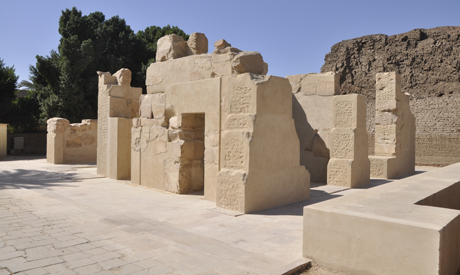At the end of February visitors to Karnak Temples will be able to admire the second chapel of the 18th dynasty Queen Hatshepsut after four years of restoration and reconstruction.
The chapel was constructed in limestone to worship Thebes ancient Egyptian god Amun-Re. It includes an open court and two inner halls embellished with blocks engraved with very distinguished religious scenes depicting Hatshepsut before Amun-Re, with her husband king Thutmose II, as well as their cartouches. Some of the blocks bear the name of Hatshepsut's predecessor king Thutmose III.
Minister of State for Antiquities Mohamed Ibrahim said that the majority of blocks of this chapel were found scattered at the beginning of the 20th century in the Karnak courtyard cachette where a collection of gigantic colossi of different New Kingdom kings, queens, nobles and top officials as well as deities were discovered. Another batch of the blocks, Ibrahim added, was found in mid 1950's during excavation works carried out by Sheata Adam and Farid El-Shaboury at the cachette.
All blocks were stored in Karnak galleries until 2005 when the mission of the Centre Franco-Egyptian D'Etude des Temples de Karnak (CFEETK) restored the blocks, studied them and published their findings.
The blocks stood on mastabas at the open air museum until 2008 when the CFEETK started a comprehensive reconstruction work on all chapels that were dismantled in previous ages.
Some of its blocks were used in the construction of other monuments inside Karnak and elsewhere in Luxor.
Hatshepsut's limestone chapel was reconstructed at the entrance of the open court, along with another one of her chapels known as the Red Chapel, the White Chapel of king Sanusert I, and the calcite shrine of king Amenhotep II.
Mansour Boreik, the supervisor of Luxor Antiquities, told Ahram online in a telephone interview that the newly reconstructed chapel, which is known as the "Sacred Monument," is a very important monument in ancient Egyptian history since it is one of the few still surviving records that attests explicitly to the power of Hatshepsut as ruler before her ascendancy to the throne as king.
Karnak Temples on Luxor's east bank is a vast mix of ancient Egyptian temples, chapels, pylons, and other buildings in ruins. Construction at the complex began in the reign of the Middle Kingdom king Sesostris I and continued into the Ptolemaic period, but most of the buildings date to the New Kingdom.
Karnak complex gives its name to the nearby modern village of El-Karnak, some 2.5 kilometres north of Luxor.
Reconstruction work on this chapel is now completed and it would be open to public end of February.
Source: Ahram








0 Comments:
Post a Comment
We appreciate comments, but we delete SPAM.